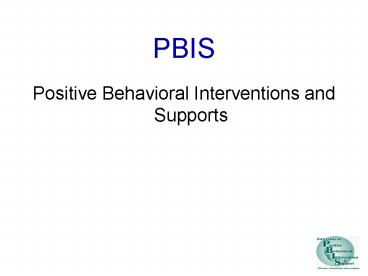PBIS - PowerPoint PPT Presentation
1 / 30
Title:
PBIS
Description:
... office referrals, increase attendance, enhance academic engagement, improve grades ... Increase attendance. Attendance Committee. SIP/SID. Target Group ... – PowerPoint PPT presentation
Number of Views:68
Avg rating:3.0/5.0
Title: PBIS
1
PBIS
- Positive Behavioral Interventions and Supports
2
Tertiary Prevention Specialized
Individualized Systems for Students with
High-Risk Behavior
CONTINUUM OF SCHOOL-WIDE INSTRUCTIONAL
POSITIVE BEHAVIOR SUPPORT
5
Secondary Prevention Specialized Group Systems
for Students with At-Risk Behavior
15
Primary Prevention School-/Classroom- Wide
Systems for All Students, Staff, Settings
80 of Students
3
ALL CHILDREN
4
Systems of Positive Behavior SupportBIG IDEAS
- Collaboration - work as a team
- Consensus - Agree and stick by agreements
- Consistency - across time, adults, students
- Logical and Realistic Solutions
- Teach and Facilitate Success
- Measure and Evaluate
- Sustain with Data-Based Decision-Making
5
Discipline Works When .
- Prevention creates more Positive than negative
consequences
Punishment (Failure)
4 1
6
PBIS Big Ideas
- PBIS is not a curriculum - it is a framework for
systems to identify needs, develop strategies,
and evaluate practice toward success - The goal of PBIS is to establish host
environments that support adoption sustain use
of evidence-based practices - (Zins Ponti, 1990)
7
Positive Approaches Keys
- Prevention before reaction
- Team and systems-based
- Logical and realistic plans
- Individualized
- Consistency across time, adults, settings, and
students - Founded on Teaching
- Goal setting and monitoring
8
ALL STUDENTS
9
Administrator Discipline Time Cost/Benefit
AnalysisUrban Elementary, Baltimore, MD
10
Obtain 80 Staff Consensus
- A YES vote means that I agree to
- Provide input in determining what our schools
problems are and what our goals should be - Make decisions about rules, expectations, and
procedures in the commons areas of the school as
a school community - Follow through with all school-wide decisions,
regardless of my feelings for any particular
decision - Commit to positive behavior support systems for a
full year - allowing performance toward our goal
to determine future plans
11
Predictable Problems Summary
12
Collaborative Solutions
13
Teaching
- Create a discussion of each big idea - and the
corresponding rule - Discuss their application in different areas of
the school - Engage students in discussion and allow
practice/demonstration time - Remind students (prompts, cues, pre-corrects)
- Encourage and reinforce success
- Discourage and provide correction/consequence for
failure with rules - Provide re-teaching as indicated by failure
- Remove prompts as indicated by success
- Consider more direct teaching in complex areas
(e.g., playground)
14
EXAMPLE Teachable Expectations
- 1. Respect Yourself-in the classroom (do your
best)-on the playground (follow safety rules) - 2. Respect Others-in the classroom (raise your
hand to speak)-in the stairway (single file
line) - 3. Respect Property-in the classroom (ask
before borrowing)-in the lunchroom (pick up your
mess)
15
Sample Teaming Matrix
16
Teaching Matrix Activity
17
(No Transcript)
18
(No Transcript)
19
(No Transcript)
20
Consistent Consequences
- Reinforcement
- Continuum of reinforcers for different levels of
success - Use the least amount necessary
- Immediate and consistent to begin
- Approximate and/or pair with natural reinforcers
- Make part of routine and systems
- Pre-plan and teach consequences
- Fade
- Move toward more natural reinforcers
- Use more group contingencies
- Increase ratios of behavior to reinforcement
21
Consistent Consequences
- Responding to negative behavior
- Immediate and consistent
- Try to keep with natural consequences
- Use the least amount necessary to get desired
behavior Pre-plan and teach - Correction and re-teaching
- Use only with reinforcement for replacement
behavior - Should defeat function of problem behavior
22
Measure and Evaluate
- Big Ideas
- School determines what outcomes are important
- School identifies the simplest way to get that
information - School uses that information to evaluate their
plans
23
Decision Flowchart
24
(No Transcript)
25
Who?
26
When?
27
Where?
28
Cool Tool
29
Acknowledging SW Expectations Rationale
- Humans require regular frequent feedback on
their actions - Humans experience frequent feedback from others,
self, environment - W/o formal feedback to encourage desired
behavior, other forms of feedback shape undesired
behaviors
30
Resources
- www.pbis.org
- www.coe.ufl.edu/faculty/scott/terrys/tscott.html































